
The Truth About Ia Drang Valley Battle
There were two battlefronts at Ia Drang Valley: the first one was a ground force action performed by the 1st Air Cavalry Division, focusing at LZ X-Ray, from 14 to November 17, 1965; and the second one was an air force action performed by B-52 bombers, expanding all over the Chu Pong/Ia Drang complex areas, from 15 to November 19, 1965. The ground force action was a diversionary maneuver in support of the air force action: its purpose was to prepare and fixe the targets for Arc Light airstrike.
It all started with the appellation Chu Pong Operation; then due to changes in the enemy military situation, it became Pleime-Chupong Campaign subsequently, then Pleime-Chupong-Iadrang Campaign
Chu Pong Operation
End of 1964, Chairman Mao Zedong of Red China turned on the green light for the Viet Cong to upgrade attacking forces to divisional level in its conquest of South Viet Nam. In the meeting dated 10/05/1964, Mao Zedong told Pham Van Dong :
“According to Comrade Le Duan, you had the plan to dispatch a division [to the South]. Probably you have not dispatched that division yet. When should you dispatch it, the timing is important.” (1)
Beginning of 1965, the NVA 304th Division received the order to prepare to infiltrate South Vietnam:
“Early 1965, the Joint General Staff summoned the 304th division commander and me to give us the order to enter the South on a combat mission.” (2)
In August 1965, the NVA 304th Division received the order to intensify preparation to go to Central Highlands by September:
“Early August 1965, the Defense Ministry gave the order to 304th Division Commander "to bring the entire 304th Division to battlefront B… all preparations must be achieved within two months." (3)
In September of that year, B3 Field Front Command finalized the Plâyme Campaign to be conducted with its three regiments – the 32nd, the 33rd, and the 66th.
The plan was to be carried out in four phases: 1) The 33rd Regiment would put up a siege of Pleime camp to lure II Corps’ main force out of Pleiku City; 2) The 33rd Regiment would ambush and destroy the relief force; 3) Both Regiments would combine force and overrun the camp; 4) The 66th Regiment would combine force with the two regiments to conquer Pleiku City.
The Viet Cong conceived the Plâyme Campaign with the direct help of Red China. A Chinese Advisors General Staff Headquarters was established in Phnom Penh to coordinate the campaign:
“The natural corridors often mentioned by General Delange in 1951 would not be efficient without the existence of Cambodia, without the concealment of Red Chinese advisors who enjoyed full amenities living in Phnom Penh, without the excellent communication by ways of telephone and airgram between Phnom Penh and Hanoi.” (4)
It was the intercepts of open radio communication of the Chinese Advisors between the Phnom Penh headquarters and the regimental battlefield command posts that allowed II Corps Command to obtain a real-time intelligence of the enemy military situation throughout the campaign and to design a flexible counter-measure plan accordingly, which lead to the victory of Pleime Campaign:
“Therefore this time around, the determination not to allow the enemy to escape, coupled with the solid intelligence on the enemy situation had permitted the battle to develop to maximum degree and scale and at the same token lead to the biggest victory ever achieved by the ARVN and its Allied.” (5)
In September 1965, II Corps Command conceived the Chu Pong Operation. The intention was to crush the three NVA regiments at the precise moment they congregate at their assembly areas to stage for the imminent attack in Chupong with B-52 carpet bombing, even before they could act:
“The Chu Pong base was known to exist well prior to the Pleime attack and J2 MACV had taken this area under study in September 1965 as a possible B-52 target.” (6)
Pleime-Chupong Campaign
However, on September 19, B3 Field Front Command decided to start the attack sooner with only the two 32nd and 33rd Regiments and intensified the preparation one month before the attack:
“As early as 19 September - one month before the attack - a thorough preparation down to the lowest level was carried out. Numerous exercises and rehearsals were conducted by each unit on maps and rehearsals were conducted by each unit on maps and sand tables. Meanwhile, transportation companies assisted by forced local laborers were rushing to prestock rice and ammunition.” (7)
II Corps Command reacted with a modified plan: Pleime-Chupong campaign.
The operational concept was: to repulse the attacking enemy and wait for the two 32nd and 33rd Regiments to regroup with the 66th Regiments in Chu Pong to use B-52 airstrike as pre-planned.
The execution of the plan was to be carried out in two phases: 1) to repulse the attacking enemy; 2) to herd the decimated troops of the two attacking regiments back to Chupong.
- Phase I: Repulsing with Dan Thang 21 operation
When the 33rd Regiment attacked Pleime camp on October 19, II Corps Command took up the challenge:
“II Corps Commander decided to play the enemy's game. Since the VC expected to successively eliminate our forces the scheme of maneuver had to make the best use of the factor TIME and to exploit the inherent weaknesses of the enemy troop disposition.” (8)
In the afternoon of October 20, an Armored Task Force was dispatched to rescue the camp, and on October 21, a group of two SF Ranger companies was sent in to reinforce the camp.
US Air Force was used as the main force to repulse the enemy at both camp and ambush sites:
- at Pleime camp
“For the next ten days [following October 19], air power played a key role in breaking the attack. In 696 day and night strike sorties, B-57s, AIEs, F-100s, and F-8s rained 866,300 pounds of GP bombs, 250,380 pounds of frag bombs, 485,880 pounds of napalm, plus rockets, CBUs and cannon fire on VC positions as close as 35 meters from the outpost walls. When it was over, the enemy had lost 326 killed in action by body count, and the camp’s defenders estimated that up to another 700 dead had been carried off. This was the largest close air support operation of the war, and perhaps the most effective.” (9)
- at the ambush site
“The airborne FAC in the flareships on station directed 74 strike sorties, with the fighters using napalm, general purpose, frags, CBU, 2.75 rockets and 20 mm cannon in support of the column. “Puff”, the AC-47, dropped 25 flares and expended 4,000 rounds of 7.62 mm minigun fire against the attackers. By 0930, 24 October, fire on the convoy had dwindled to small arms, and by 1300 the VC broke contact because of the air strikes.” (9)
- Phase II: Herding with Long Reach operation
Pleime camp was liberated. II Corps Command learned through intelligence source that the two 32nd and 33rd Regiments were ordered to withdraw and prepare for another attack together with the 66th Regiment:
“Dan Thang 21 operation finished, Pleime camp was back on its footing, but among the two VC Regiments that had joined in the attack, we only inflicted the enemy with more than 400 killed. The withdrawal was a rational and intelligent initiative taken by the VC Field Front Command. But the enemy would attempt to take revenge and furthermore, the remote Pleime camp remains an eye sore to them.” (10)
The mission of herding the enemy troops was assigned to 1st Air Cavalry Division with Long Reach operation:
“Therefore the decision to organize an enemy pursuit of II Corps Command, in which 1st Air Cavalry Division is the main effort and ARVN Airborne Group is the reserved force ready to intervene when necessary, was wholeheartedly accepted by the entire division, because rarely a unit got the chance to open its first history pages with a Trường Chinh (Long Reach) operation.” (11)
And to keep the enemy’s tongue wet, while extending the TAOR of 1st Air Cavalry Division, II Corps command retained the control of Pleime camp; thus, it still appeared vulnerable to an enemy’s attack:
“- At 292350 Col Williams called Col Hieu, CofS II Corps. II Corps requested that 1st Cav TAOR be extended to include the Plei Me area except the camp itself.” (12)
Long Reach operation was carried out with two phases: All the Way operation with 1st Air Cavalry Brigade and Silver Bayonet I with 3rd Air Cavalry Brigade.
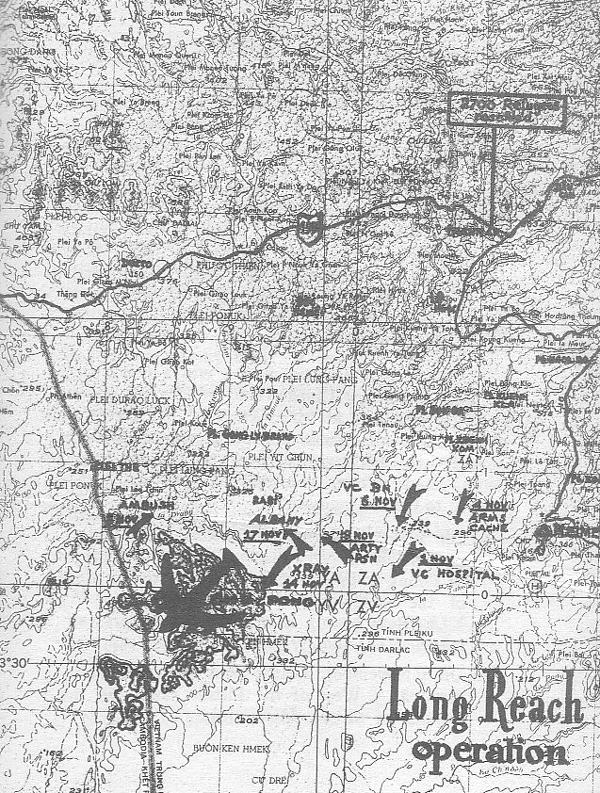
All the Way operation (October 27-November 9)
The 1st Air Cavalry Brigade set out to herd the scattered small units of the 33rd Regiments back to Chu Pong, meanwhile G2/II Corps monitored their migration through radio intercepts:
“On 10/27, the lead elements of the 33d had closed on it forward assembly area, the village Kro (ZA080030); on 10/28, the 32d Regiment had nearly closed its base on the north bank of the Ia Drang; on 10/29, the 33d Regiment decided to keep the unit on the move to the west, to Anta Village ( YA940010), located at the foot of the Chu Pong Massif; on 11/1, the 33rd regiment headquarters closed in at Anta Village; on 11/2, by 0400 hours, the 2d, the regimental CP had arrived at Hill 762 (YA885106); on 11/05, units of 66th Regiment continued to close in the assembling areas in the Chupong-Iadrang complex; on 11/07, the depleted 33d Regiment licked its wounds and waited for its stragglers to come in, meanwhile the remainder of Field Front forces were quiet; on 11/08, only fragmented units and stragglers remained east of the Chu Pong-Ia Drang complex; on 11/09, the 33d Regiment gathered in the last of its organic units.” (13)
Silver Bayonet I (November 9- November 17)
On November 9, the 3rd Air Cavalry Brigade replaced the 1st Air Cavalry Brigade and had the mission to entice B3 Field Front to regroup its three regiments to stage for the second attack of Pleime camp:
“By this time Field Force Vietnam had asked the division to consider moving this operation east of Pleime.” (14)
“The movement and shift in emphasis from west to east were to further stimulate a forthcoming decision from the NVA division headquarters.” (15)
“With American units seemingly withdrawing to the east of Pleime, the decision was to attempt to regain its early advantage with an attack. The target once again was the Pleime CIDG Camp. The division headquarters set the date for attack at 16 November, and issued orders to its three regiments.” (16)
On November 11, the 66th Regiment was at (center of mass vic YA 9104); the 32nd (YA 820072), the 33rd (YA 940011). They became available targets for B-52 airstrike.
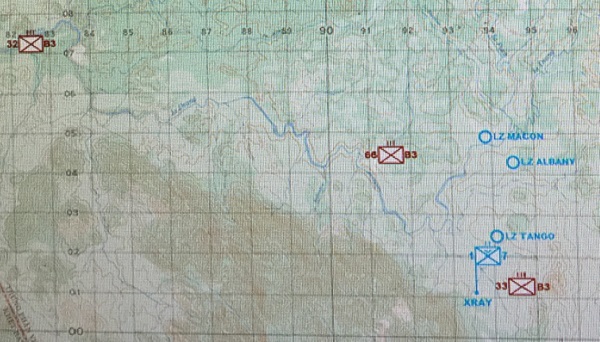
The time over target was set for 16:00 hours on November 15 at the enemy force’s center of mass (vicinity YA8702).
To accommodate the slowness of the B-52’s action – which required a 72-hour notification and an eight-hour flight from Guam to Chupong - on November 12, 1/7 Air Cavalry Battalion was ordered to get ready for a diversionary tactic operation to be executed at Chupong’s east side footstep. On November 14, 1/7 Air Cavalry Battalion air assaulted LZ X-Ray, forcing B3 Field Front Command to postpone its attack of Pleime camp and to focus its attention on dealing with the new threat:
“Brother Chu Huy Man, Commander, brother Dang Vu Hiep, Political Commissar and I at the headquarters were making arrangements to prepare for a second phase of action against a target near Pleime. Upon receiving news from all directions reporting that the Americans had inserted troops, we issued an order to delay the attack of Chu Ho.” (17)
As the purpose of the insertion of 1/7th Air Cavalry Battalion was only to divert the enemy troops' attention, it was planned so that it did not appear too big of a threat as to scare them away: a lot of noise was created with a 20-minute pre-artillery prep and a thundering arrival of a majestic armada of 16 helicopters; the closing in was intentionally slow with a 5 hour scheduling; the ratio of troop balance was maintained at 2:2 with NVA 7th and 9th Battalions versus US 1/7th and 2/7th Air Cavalry Battalions, and when the 2/5th Air Cavalry Battalion's reinforcement was needed, it closed stealthily in by foot after a 5 hour march from LZ Victor on November 15; then on November 16, as the enemy was about to realize they were outnumbered, the 1/7th Air Cavalry Battalion was pulled out, leaving behind the 2/7th and the 2/5th at LZ X-Ray.
On November 15, at 1600 hours, the first waves of B-52's struck at center of mass vic YA 8702, about 7.5 kilometers west of LZ X-Ray, aiming at the 32nd Regiment positions. On November 17, after the three 1/7, 2/7 and 2/5 Air Cavalry Battalions had abandoned LZ X-Ray, B-52's struck the landing zone itself, aiming at the 66th Regiment troops still lingering around the area.
B-52 carpet bombing continued for five consecutive days:
“For five consecutive days, from 15 to 19 November, the giant B52 bombers had flown a total of 96 sorties. One after the other, the areas of the Chu Pong massif - each of 20 square miles - underwent a systematic earthquake spreading from West to East. VC bunkers and trenches which so far had resisted the strikes by tactical aircraft and artillery began to score direct hits by the 750-pound bombs. The heavy canopy of the jungle ceased to be effective in both concealment and cover. The "back door" into Cambodia was closed and to escape, the VC remnants were reduced to utilize the narrow valley of the Ia Drang.” (18)
On November 15 and 16, B-52 airstrikes aimed mainly at the positions of units of the 33rd and 32 Regiment; on November 17, 18 and 19, units of the 66th Regiment; and on November 20, units of the 32nd Regiment. ̣
Pleime-Chupong-Iadrang Campaign
On November 17, intelligence source intercepted communications indicating B-52 airstrikes caused the enemy to suffer around 2,000 killed and the two surviving Battalions – 635th and 334th – had received order to withdraw to Cambodia through the narrow corridor of Ia Drang river, the first along the north side of the river and the latter the south side, II Corps decided to finish off the campaign with operation Than Phong 7 conducted by five ARVN Airborne battalions.

On November 18, a new artillery support base was established at LZ Crooks (YA 875125), secured by 2/5 Air Cavalry Battalion.
Based on precise intelligence source, 3rd and 6th Airborne Battalions were inserted in the northern area of Ia Drang in the afternoon of 11/18 in order to ambush 635th Battalion at YA 805080 on 11/20.
And also based on accurate intelligence source, the four 5th, 6th, 7th and 8th Airborne Battalions –after crossing Ia Drang river to the southern side (3rd Airborne Battalion reverted to the northern side to destroy three training centers), set up an ambush site to intercept 334th Battalion at YA 815070 on 11/24.
The 38-day long campaign ended on November 26:
“On November 24, as no more contacts were made with the enemy, the Airborne Brigade withdrew from the area of operations and the 3rd phase of Pleime campaign ended at 18:45H on November 26 with 265 VC killed (BC), 10 others and 58 weapons captured.” (19)
Conclusion
The truth about Ia Drang Valley Battle is then that it was an Arc Light operation, supported by a ground force in which the 1st Air Cavalry’s role was to set up and fix the targets for B-52 airstrikes.
Sidebar: An ARVN-US Joint Operation
The Pleime campaign is an ARVN-US joint operation with a clear cut modus operandi in which the intelligence and operational concept were provided by the ARVN, and in which the command and the deployment of forces were separate (during the Pleime phase, it was conducted by the ARVN Armored Task Force; during the Chupong phase, by the US 1st Air Cavalry Division; and during the Iadrang phase, by the ARVN Airborne Group).
The operation for the Chupong phase was named Long Reach by II Corps Command, a translation of Trường Chinh:
“Therefore the decision to organize an enemy pursuit of II Corps Command, in which 1st Air Cavalry Division is the main effort and ARVN Airborne Group is the reserved force ready to intervene when necessary, was wholeheartedly accepted by the entire division, because rarely a unit got the chance to open its first history pages with a Trường Chinh (Long Reach) operation.” (11)
General Westmoreland acknowledges the key role of the ARVN in this joint operation:
“From the standpoint of employment of joint forces, the Plei Me battle was a classic. The signal successes of the latter phases could, perhaps, never have been realized had it not been for the judgment and foresight of Vietnamese leadership. The initial preparatory effort on the ground, paving the way for the introduction of the 1st Air Cavalry Division, was accomplished by Vietnamese forces. Similarly, the very successful final phase exploitation was accomplished largely by the Vietnamese Airborne Brigade. The effectiveness of this highly organized, closely integrated, cooperative effort has not often been emulated in modern warfare.” (20)
The American commanders involved in this joint operation were: General DePuy, J3/MACV, Saigon; General Larsen, IFFV, Nha Trang, in charge of American forces operating in II Corps; General Kinnard, 1st Air Cavalry Division, An Khe; General Knowles, 1st Air Cavalry Division/CP Forward, Pleiku.

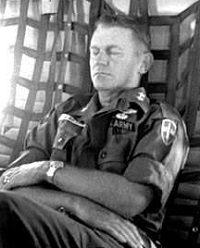
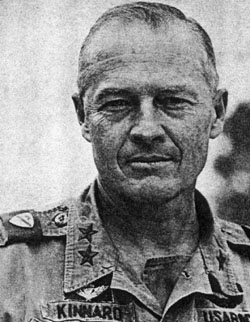
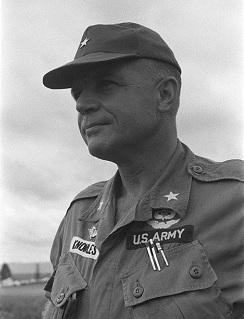
General DePuy was in charge of coordinating Arc Light operation with ARVN II Corps:
“- 10:30H: MAVC J3 (Gen DePuy) Gen DePuy called Col Barrow and asked if Arc Light had been cleared with CG II Corps. Col Barrow replied yes, CG II Corps has approved Arc Light. Target area approved by Col Barrow and Col McCord. Also Gen DePuy wanted to know if the elem of 1st Cav had received the 151600H restriction on not going west of YA grid line. Col Barrow informed Gen De Puy that the 1st Cav had acknowledged receipt of the restriction and would comply. Gen DePuy personally changed target configuration.” (G3 Journal/IFFV, 11/14)
There is an indication that he was also closely implicated with the ground force operation when he summoned Colonel Hal Moore to Saigon to brief him:
“- 21:05H: 1st Cav (Col Beaty): Lt Col Moore will arrive Saigon 1130 in morning (to brief Gen DePuy).” (G3 Journal/IFFV, 11/15)
General Kinnard delegated the direct command of the Long Reach operation to General Knowles, who set up a command post next to II Corps Command headquarters in Pleiku.
General Kinnard and General Knowles did not have free hands in the direction of the Long Reach operation, with General Larsen intervening on the field to give tactical maneuvering orders:
“- 11/08: By this time Field Force Vietnam had asked the division to consider moving this operation east of Pleime if it appeared that was no further contact imminent in the west. (Pleiku Campaign, page 67)
“- 11/12: That day, General Larsen was visiting the division’s forward command post at the II Corps compound. He asked Knowles how things were going. Knowles briefed him on the attack on Catecka the night before and then told him the brigade was drilling a dry hole out east of Plei Me. Larsen said, “Why are you conducting operations there if it’s dry?” Knowles’s response was, “With all due respect, sir, that’s what your order in writing directed us to do.” Larsen responded that the cavalry’s primary mission was to “find the enemy and go after him.” Shortly after, Knowles visited Brown at the 3rd Brigade command post and told him to come up with a plan for an air assault operation near the foot of the Chu Pongs.” (Coleman, Pleiku, page194)
“- 11/16: At Xray, the enemy broke off, we didn't quit. We were no longer interested in Xray. That piece of ground meant nothing to me. I wanted to go on to where the enemy was. But Swede ordered me to stay in that spot and I stayed there an extra 24 hours.” (Cochran, Alexander S., "First Strike at River Drang", Military History, Oct 1984, pp 44-52, Per. Interview with H.W.O Kinnard, 1st Cavalry Division Commanding General)
The mastermind of the entire Pleime-Chupong-Iadrang was Colonel Hieu, II Corps Chief of Staff, who designed the operational concept of using Arc Light strike to destroy the three NVA 32nd, 33rd and 66th Regiments at Chu Pong. He was mentioned at least twice in the G3 Journal of IFFV that recorded the Pleime campaign:
(1) “- 08:20H: II Corps Capt Ushijima - Who if anyone at Pleiku can make a Cmd decision if necessary in Vinh Loc's absence? Request you stay on top of Than Phong 6, Plei My and route 21 Opns and ensure timely and accurate info forwarded this HQ. Asn: Chief of Staff is here and has contact w/CG on coast. Question: Can CofS make a decision. Ans: He will have to check w/CG before making a decision.” (G3 Journal/IFFV, October 21)
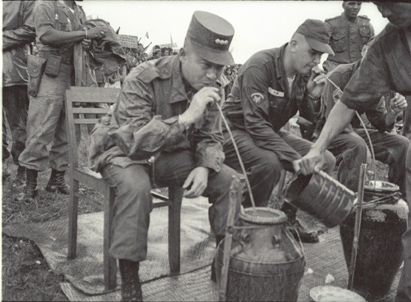
(2) “ - 00:50H: II Corps (Major Black) At 292350 Col Williams called Col Hieu, CofS II Corps. II Corps requested that 1st Cav TAOR be extended to include the Plei Me area except the camp itself. From present line on NS grid line ZA14 east to NS grid line AR77, on EW grid line ZA/AR15, south on AR77 to EW grid line 00, then west to NW grid line ZA14. Col Buchan, Gen Knowles, Col Williams and Col Mataxis agree.” (G3 Journal/IFFV, October 29)
- (1) Vietnam War, 1961-1975, Wilson Center
- (2) General Nguyen Nam Khanh, Quan Doi Nhan Dan magazine, 11/13/2005
- (3) Nguyen Huy Toan and Pham Quang Dinh, 304th Division, volume II, pp 19-42
- (4) General Vĩnh Lộc, Pleime, Trận Chiến Lịch Sử, page 124
- (5) General Vĩnh Lộc, page 94
- (6) General McChritian, J2/MACV, Intelligence Aspect of Pleime/Chupong Campaign, page 6
- (7) General Vinh Loc, Why Pleime, chapter III, page 47
- (8) General Vinh Loc, chapter IV, page 55
- (9) Project CHECO Report, The Siege of Pleime, 24 February 1966
- (10) General Vĩnh Lộc, page 94
- (11) General Vĩnh Lộc, page 101
- (12) G3 Journal/IFFV, 10/30 entry
- (13) General McChristian, pp. 16-44
- (14) General Kinnard, Pleiku Campaign, page 67
- (15) General Kinnard, page 73
- (16) General Kinnard, page 76
- (17) General Nguyen Huu An, Chiến Trường Mới– Hồi Ức
- (18) General Vinh Loc, chapter VI, page 97
- (19) General Vĩnh Lộc, page 132
- (20) General Vinh Loc, Why Pleime, Preface
- All the above reference sources can be seen online (scroll further down to "documents" and click on link, if available)
Tin Nguyen
Violent Skies Symposium
Air War Over Vietnam
15-16 October 2015
National Defense University, Washington D.C.
- Operation Pleime-Chupong B-52 Strike?
- The Use of B-52 Strike in Ia Drang Campaign, General Westmoreland’s Best Kept Military Secret
- Air War Over Pleime-Chupong
- Arc Light over Chu Pong Operation
- Catching a Thief Tactic in Pleime Campaign
- Pleime/Chupong Campaign Destroying B3 Field Front Base
- The Uniqueness in Pleime Counteroffensive Operational Concept
- Pleime Counteroffensive into Chupong Iadrang Complex
- The Unfolding of Strategic and Tactical Moves of Pleime Campaign
- Battle of Pleime
- The Truth about the Pleime Battle
- Intelligence Gathering at Ia Drang
- Intelligence, the Key Factor in the Pleime Campaign's Victory
- Roll Call of Combatants at Pleime-Chupong-Iadrang Battlefront
- "Victory at Pleime" ?
- Tactical Moves in Pleime Battle
- Kung Fu Tactics at Pleime Campaign
- Various Diversionary Moves in Support of Arc Lite Strike in Pleime Counteroffensive
- What if there was no master plan for Pleime Counteroffensive?
- Pleime/Chupong Campaign Destroying B3 Field Front Base
- A Few Things You Should Know about Pleime-Iadrang Campaign
- Things the VC Don't Want People To Know at Pleime Battle
- Reviewing "Why Pleime"
- Review of "Intelligence Aspects at Pleime_Chupong Campaign"
- Perplexing Maneuvers at Pleime-Chupong-Iadrang You Might Be Attempted to Question
- A Bird’s-Eye-View of Pleime Campaign
- Operation Dan Thang 21
- US Air Force’s Roles in Pleime Campaign
- Arc Lite Operation Planning and Execution in Pleime Offensive
- A Doctrinal Lesson on the Use of Arc Lite in Pleime Counteroffensive
- Command and Control of Arc Light Strike at Chupong-Iadrang
- A Military Genius in Action at Pleime-Chupong-Iadrang Battlefront
- Command and Control Skills in Pleime Campaign
- Behind-the-scenes Activities at Various Allied Headquarters During Pleime Campaign
- The Two Principals Players Of Pleime Chess Game
- Pleime Battle's Diary
- Pleime Campaign and Pleiku Campaign
- A New Look at Ia Drang
- Operation Long Reach
- LZ X-Ray Battle (General Knowles)
- My Contributions to the Battle of Ia Drang in Wikipedia
- Operation LZ X-Ray
- Colonel Hal Moore’s Self-Aggrandizement in “We Were Soldiers Once ... and Young”
- Colonel Hal Moore Misunderstood his Mission at the Ia Drang Battle
- What Historians Failed to Tell About the Battle at LZ X-Ray
- Hal Moore and 1/7th Air Cavalry Battalion's Real Mission at LZ X-Ray
- Two Different Narrations of LZ X-Ray Battle by II Corps
- Ia Drang Valley Battle? Which One?
- LTC Hal Moore Summoned to a Woodshed Session?
- Colonel Hieu's Operational Concept for LZ X-Ray
- LZ Albany Battle - Chinese Advisors' Perspective
- A Puzzling Air Assault Performed by 1/7 Air Cavalry at LZ X-Ray
- Two Different Narrations of Than Phong 7 Operation by II Corps
- General Schwarzkopf's Naïveté In Ia Drang Battle
- Venturing into Lion's Den in Ia Drang Valley
- American Perspective of Pleime Battle
- General Kinnard's Naïveté in Pleime Campaign
- "No Time for Reflection at Ia Drang" ?
- Pleime Campaign or Pleime-Ia Drang Campaign?
- A Critique of General Bui Nam Ha's Opinions about Plâyme Campaign
- Commenting on General Nguyen Huu An's Account of Plâyme Campaign
- Crushing the American Troops in Western Highlands or in Danang?
- What Really Happened at Ia Drang Battle
- Case Study of a Typical Misinterpretation of Ia Drang Battle
- Ia Drang Battle Revisited
Documents
- Why Pleime
- Pleime, Trận Chiến Lịch Sử
- Pleime Battle Viewed From G3/I Field Force Vietnam
- Long Reach Operation Viewed From G3/I Field Force Vietnam
- LZ X-Ray Battle and LZ Albany Battle Viewed From G3/I Field Force Vietnam
- Than Phong 7 Operation Viewed From G3/I Field Force Vietnam
- Arc Light Strike at Chupong-Iadrang Viewed From G3/IFFV
- Pleiku Campaign
- Intelligence Aspects at Pleime_Chupong Campaign
- Excerpts of General Westmorland’s History Notes re: Pleime-Chupong-Iadrang Campaign
- LZ X-Ray Battle (General Knowles)
- LZ X-Ray After Action Report - LTC Hal Moore and Colonel Hieu
- Than Phong 7
- 52nd Combat Aviation Battalion in Support of Pleime Campaign
- CIDG in Camp Defense (Plei Me)
- Viet Cong Requested Red China's Aid
- Battle of Duc Co
- NVA Colonel Ha Vi Tung at Pleime-LZ Xray-LZ Albany
- The Fog of War: The Vietnamese View of the Ia Drang Battle
- No Time for Reflection: Moore at Ia Drang
- 1st US Cavalry Division Gives Support in the Battle at Plei Me
- Plei Me Fight Stands As War Turning Point
- Plei Me Battle
- Seven Days of Zap
- Pleime Through New York Times' View
- First Engagement With American Troops at Pleime-Iadrang
- Pleime Campaign
- Crushing the American Troops in Central Highlands
- NVA 66th Regiment in Pleime-Ia Drang Campaign
- The Political Commissar at the First Battle Against the Americans in Central Highlands
